Contents
Market Overview
Macro Review
Softening inflation allows markets to breath. U.S. CPI came in at 6.5% which was in line with expectations, with a decline in the energy component which supported the idea of the Fed moderating its hawkish path. Former Fed member, Tim Duy, suggested that two more CPI reports between now and the March FOMC would allow the Fed to seriously consider pausing the tighter policy and lower dots in the updated Summary of Economic Projections. In fact, the market is pricing in less than 50bp of tightening at both the February and March FOMC meetings combined. The second theme relates to the rally in JPY as the BoJ’s Yield Curve Control policy is coming under renewed scrutiny as JGB futures traded down to the lowest level since 2014. There is hope that the policy could be abolished under Governor Kuroda and before PM Kishida announces the new governor, which is expected in early February. The third theme of 2023 is the rally in European fixed income and equities. European gas prices have continued to trade down with a milder winter and inflation expectations have collapsed markedly. This has given way to a strong rally in government bonds. European stocks are now trading at a seventh-month high, just as copper sits at a six-month high with a 10% gain during the past week alone. However, the trend is never uniform. After moderating inflation in Australia, the RBA was back under pressure with retail sales rising 1.4% and CPI coming in at 7.3%, which were both comfortably ahead of prior readings and expectations. Yet, global growth is still weakening. The World Bank downgraded global growth once again to 1.7% from 3.0% last summer and the WEF released its Global Risks Report citing concern around “asset bubbles” as it labelled cryptocurrencies a “polycrisis”.
EM Credit Update
Emerging market sovereign credit (cash bonds) ended the week +1.5% with spreads 6bp tighter. EM credit spreads tightened this week with U.S. Treasuries also rallying 11-19bp, which comes after the 14-19bp rally last week. Sovereign outperformers over the week were Ethiopia, Pakistan and El Salvador, while Tunisia, Zambia and Bolivia underperformed. Other than U.S. Treasuries rallying, the second theme has been large EM sovereign issuance. The Financial Times highlighted that we have seen 14 EM sovereign credits issue bonds this year which has amounted to $41bn in just two weeks. What the Financials Times did not do was contextualize that figure. EM sovereign issuance in 2022 was just $99bn, meaning in the first two weeks of this year we have already seen 40% of the issuance volumes, which is quite remarkable.
The Week Ahead
The World Economic Forum in Davos commences on Monday. Then Japan’s CPI release will be closely watched before the next BoJ meeting, as will Eurozone CPI, just as earnings season picks up. We will also see the release of UK retail sales and CPI inflation, with the later expected to remain in double digits at 10.4%. Germany, on the other hand, saw CPI fall to 8.6% and entered the single digits for the first time since August. Germany will also publish its ZEW Survey, which will likely have a recessionary flavor to it, but one has to question whether a milder winter can soften the severity of the recession that was previously anticipated. Nevertheless, the survey is conducted by financial professionals, rather than on real economic activity, and one must question whether Goldman Sach’s view that Europe will no longer enter a recession in 2023 has biased the participants. Across EM, interest rate decisions are due out of Indonesia (5.5%) and Turkey (9.0%). Latin America is limited to economic activity releases and then Brazil will publish their inflation and labor reports. Finally, Chinese Lunar New Year celebrations begin in earnest from next Sunday, but before then it is likely that the LPR and MLF rates are left unchanged, retail sales deepen, fixed asset growth decelerates and 4Q GDP falls to 1.0%.
Highlights from emerging markets discussed below: Headlines generating unrest in Brazil have limited near-term market implications, Pakistan donor conference aimed to shore-up financing, and Peru protests continued while Congress approved new cabinet.
Fixed Income
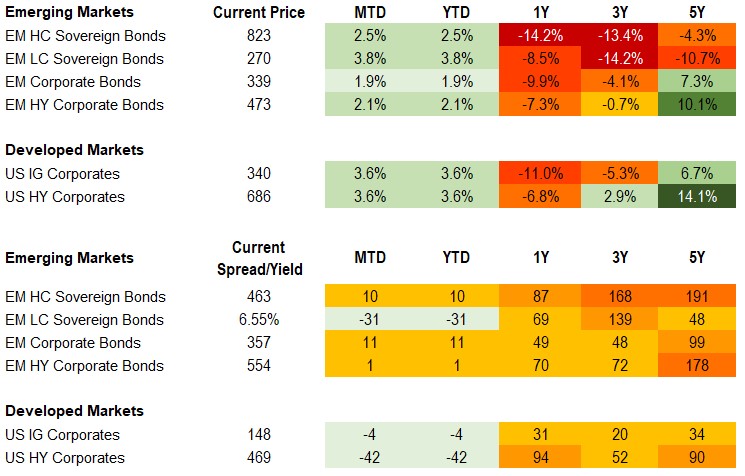
Equities
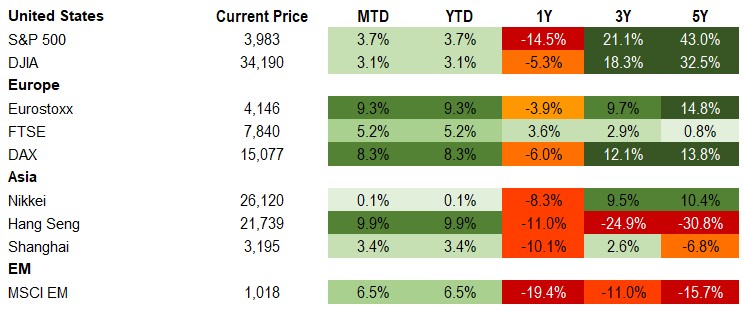
Commodities

Source for data tables: Bloomberg, JPMorgan, Gramercy. EM Fixed Income is represented by the following JPMorgan Indicies: EMBI Global, GBI-EM Global Diversified, CEMBI Broad Diversified and CEMBI Broad High Yield. DM Fixed Income is represented by the JPMorgan JULI Total Return Index and Domestic High Yield Index. Fixed Income, Equity and Commodity data is as of January 13, 2023 (mid-afternoon).
Emerging Markets Weekly Highlights
Headlines generating unrest in Brazil have limited near-term market implications
Event: Last Sunday, supporters of Brazil’s former right-wing President, Jair Bolsonaro, stormed and briefly invaded Congress, the Supreme Court and the Presidential Palace in the capital Brasilia. Newly elected left-wing President Luiz Inacio Lula da Silva was not in the palace at the time the riots broke out. These events, closely reminiscent of the January 6th invasion of the U.S. Capitol by supporters of former U.S. President Donald Trump, marked the culmination of protests by Bolsonaro supporters who refuse to accept the outcome of the Presidential Elections from last October. However, federal security forces were able to restore order quickly, the riots received widespread condemnation from most corners of Brazil’s society and attempts for follow-up protests later in the week attracted small attendances.
Gramercy commentary: We believe the near-term risk of social/political crisis in Brazil stemming from these events to be extremely limited. The days since the invasion of Brazil’s key political institutions by Bolsonaro supporters angered by the outcome of the recent Presidential Election showed that no appetite exists within the broader society and the political class for actions that could jeopardize Brazil’s constitutional order. Ironically, President Lula appears to have emerged politically stronger from the unrest in Brasilia, at least in the near-term, given the unified rejection of the violence from all three branches of government and the political class in general. However, this boost is likely to fade and concerns over social and political dynamics may increase over time in a highly polarized political context in the country. Meanwhile, Finance Minister Fernando Haddad unveiled a package of fiscal measures this week focused on raising additional budget revenues to offset higher expenditures planned by the Lula Administration. While it is still unclear to what extent the Haddad plan will translate into actual policy action, it should help further ease market concerns about the economic policy outlook under the Lula Administration.
Pakistan donor conference aimed to shore-up financing
Event: The Government of Pakistan and the United Nations hosted the International Conference on Climate Resilient Pakistan in Geneva following its Post-Disaster Needs Assessment (PDNA) indicating recovery needs of over $16bn from last year’s floods. According to statements from Pakistani authorities, commitments to the country have exceeded expectations with new funds and rollovers from the GCC including KSA and UAE as well as multilaterals such as the Islamic Development Bank and Asian Development Bank. The news comes on the back of dwindling FX reserves to below one month of import cover.
Gramercy commentary: The fresh aid commitments and debt rollovers are a step in the right direction for Pakistan to resolve its near-term balance of payment pressure, although the pending IMF review under its existing EFF arrangement and contingent bilateral funds are of greater importance . Political and social dynamics have complicated the authorities’ ability to execute on key tenets of the IMF program including fiscal policy and exchange rate flexibility. We expect uncertainty to linger over policy execution and FX reserve depletion driving asset price volatility until elections are held with solid prospects for broader external debt management, particularly given the country’s geopolitical position and limited bond debt.
Peru protests continued while Congress approved new cabinet
Event: The unrest following Castillo’s ouster in late 2022 has persisted into the new year with additional injuries, deaths, and localized economic disruption. Meanwhile, the Congress approved President Boluarte’s Cabinet, including market friendly Minister of Economy Alex Contreras, with 73 votes out of 130 lawmakers.
Gramercy commentary: While the approval of the Cabinet is constructive and should keep market volatility at bay in the near-term, the political and social backdrop in Peru remains subject to volatility with growth, particularly investment, likely hindered as a result. General elections were moved to April 2024 from 2026 following a Congressional vote in December with 93 votes in favor. However, continued calls for Boluarte’s removal leave the risk for an even earlier vote elevated. Downward rating risk should persist albeit with ratings staying within investment grade territory for 2023.
Emerging Markets Technicals
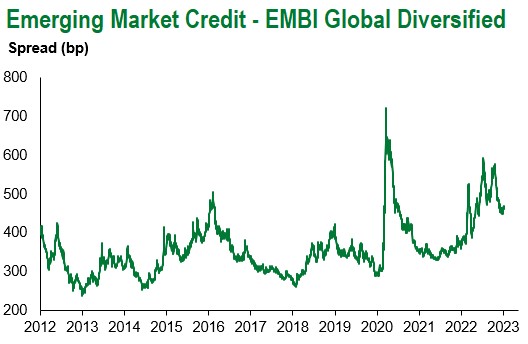
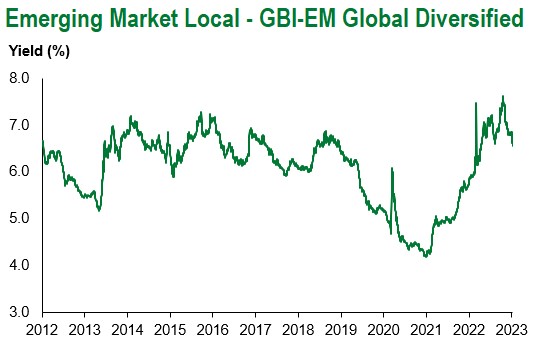
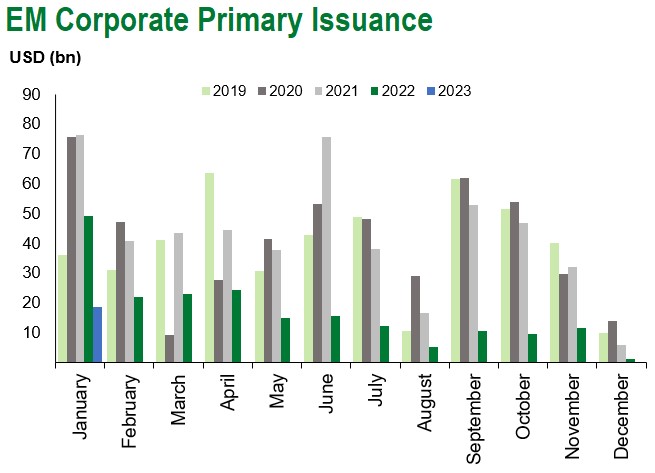
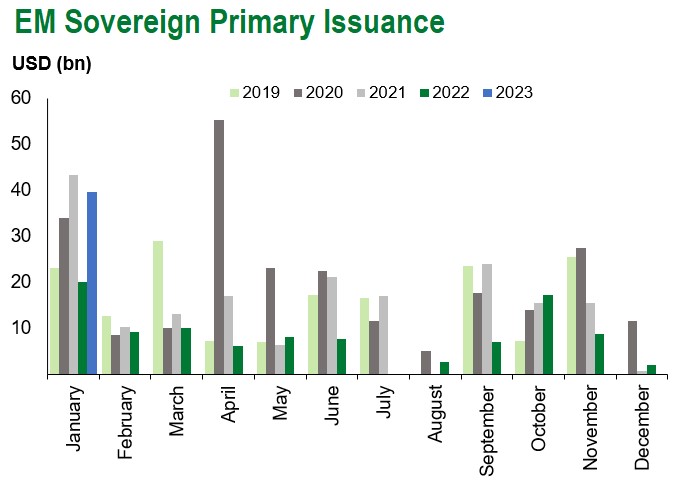
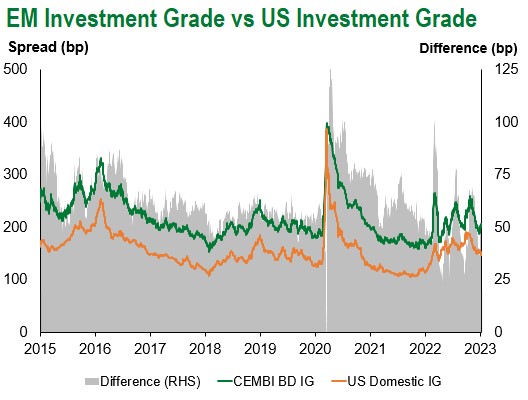
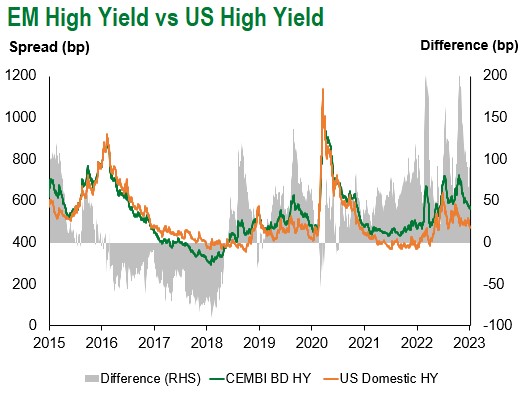
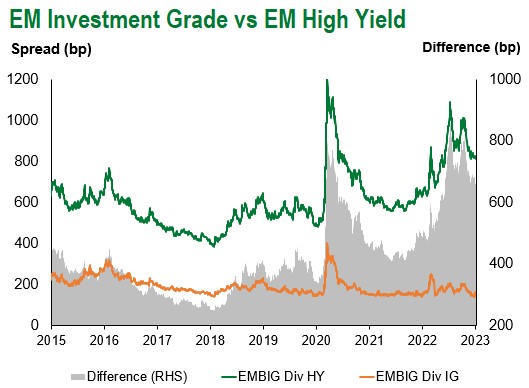
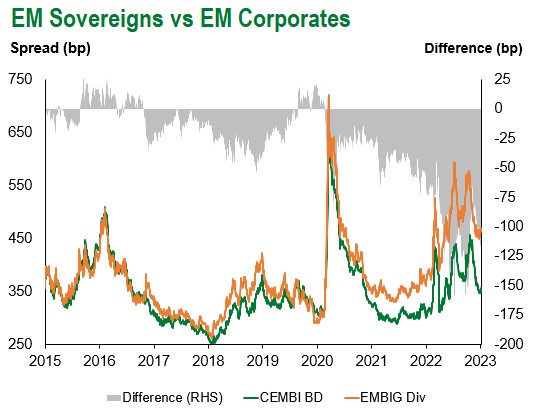
Emerging Markets Flows
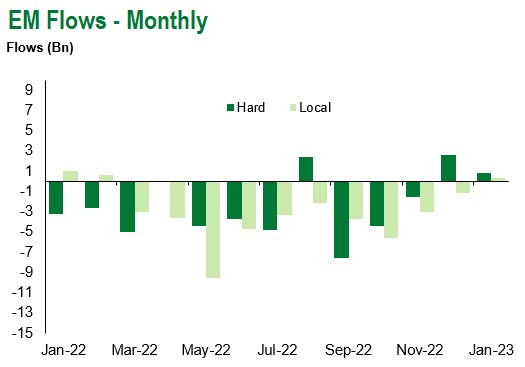
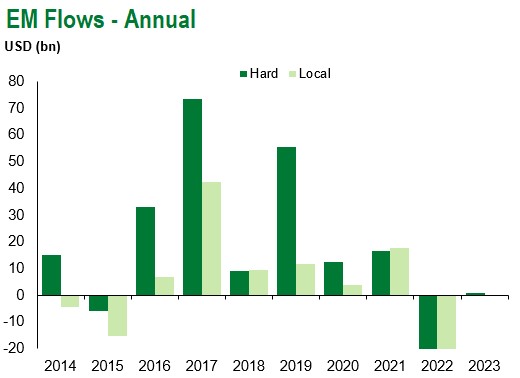
Source for graphs: Bloomberg, JPMorgan, Gramercy. As of January 13, 2023.
COVID Resources:
Johns Hopkins COVID-19 Case Tracker
For questions, please contact:
Kathryn Exum, CFA ESG, Director, Co-Head of Sovereign Research, [email protected]
Petar Atanasov, Director, Co-Head of Sovereign Research, [email protected]
James Barry, Director, Deputy Portfolio Manager, [email protected]
This document is for informational purposes only. The information presented is not intended to be relied upon as a forecast, research or investment advice, and is not a recommendation, offer or solicitation to buy or sell any securities or to adopt any investment strategy. Gramercy may have current investment positions in the securities or sovereigns mentioned above. The information and opinions contained in this paper are as of the date of initial publication, derived from proprietary and nonproprietary sources deemed by Gramercy to be reliable, are not necessarily all-inclusive and are not guaranteed as to accuracy. This paper may contain “forward-looking” information that is not purely historical in nature. Such information may include, among other things, projections and forecasts. There is no guarantee that any forecasts made will come to pass. Reliance upon information in this paper is at the sole discretion of the reader. You should not rely on this presentation as the basis upon which to make an investment decision. Investment involves risk. There can be no assurance that investment objectives will be achieved. Investors must be prepared to bear the risk of a total loss of their investment. These risks are often heightened for investments in emerging/developing markets or smaller capital markets. International investing involves risks, including risks related to foreign currency, limited liquidity, less government regulation, and the possibility of substantial volatility due to adverse political, economic or other developments. References to any indices are for informational and general comparative purposes only. The performance data of various indices mentioned in this update are updated and released on a periodic basis before finalization. The performance data of various indices presented herein was current as of the date of the presentation. Please refer to data returns of the separate indices if you desire additional or updated information. Indices are unmanaged, and their performance results do not reflect the impact of fees, expenses, or taxes that may be incurred through an investment with Gramercy. Returns for indices assume dividend reinvestment. An investment cannot be made directly in an index. Accordingly, comparing results shown to those of such indices may be of limited use. The information provided herein is neither tax nor legal advice. Investors should speak to their tax professional for specific information regarding their tax situation.
